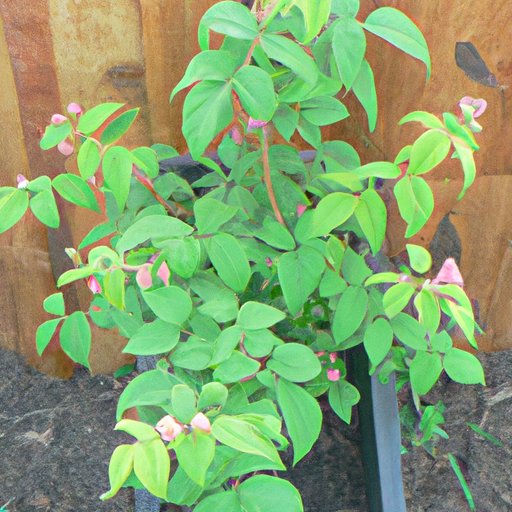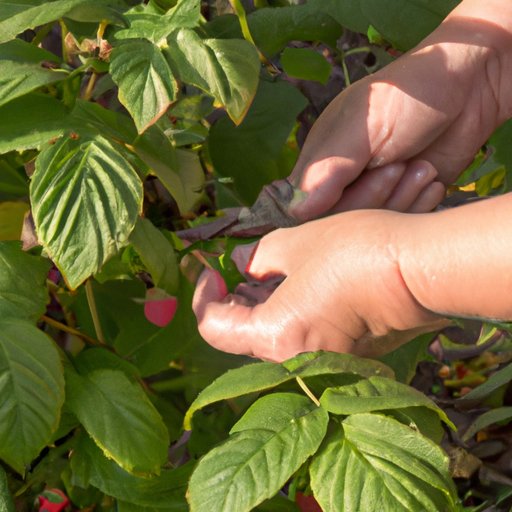
Introduction
Do you want to grow your own raspberries? These tasty, juicy, and high-nutrient berries can be a rewarding addition to any garden. However, it takes some planning and effort to grow healthy raspberry plants. In this article, we will guide you through the entire process, from planting to prunning, including advice on soil quality, pest control, and harvesting. Whether you’re new to gardening or just new to raspberries, this guide will provide you with all the information you need to grow your own raspberries successfully.
Starting from Scratch: A Beginner’s Guide to Planting Raspberry Bushes
The first step to a successful raspberry harvest is to start with healthy plant specimens. This section provides you with the tips you need to start growing from the ground up.
First, it’s essential to choose the right location for your raspberry bushes. The area should receive plenty of sunlight, have good soil drainage, and be away from other plants that might encroach on your raspberry bushes. Secondly, you must prepare the soil, ensuring it is rich in nutrients and organic matter by adding compost or well-rotted manure, a few weeks before planting. Finally, plant your raspberries!
Remember, raspberry bushes need plenty of space, so be sure to space them out appropriately. After planting, it’s a good idea to provide support for your raspberry plants. Fences, stakes or other structures can help the plants stay upright, improving air circulation and reducing the risk of pests and diseases.
The Best Soil for Raspberry Plants: Tips for Growing Juicy Berries
The soil your raspberry bush grows in has a significant impact on the plants’ health and productivity, so it’s crucial to start with the right soil conditions.
Raspberry bushes prefer well-drained, slightly acidic soil with a pH between 5.5 and 6.5. Overly wet or compacted soil can cause problems, so consider planting in a raised bed if your garden soil doesn’t have good drainage. Adding organic matter by incorporating compost, manure, or mulch can help improve soil structure, encourage beneficial soil organisms, and provide essential nutrients. While watering your plants, avoid over-saturation, which can lead to mold, rot, and other problems.
Raspberry Varieties 101: Choosing the Best Types for Your Garden
There are two common types of raspberry plants: summer-bearing and fall-bearing.
Summer-bearing raspberries typically produce one large crop each year, while fall-bearing raspberries produce two crops – one in late summer and one in early fall. Summer-bearing raspberries are generally more productive, while fall-bearing raspberries are more compact and suitable for small gardens. There are also everbearing varieties that produce fruit all season but tend to have smaller yields.
When choosing a raspberry variety, you should consider the climate, as some cultivars are more cold-hardy than others. Other factors to consider include the plant’s size, the fruit flavor, the ease of care, and, of course, the desired harvest time. Some popular varieties include Heritage (summer-bearing), Autumn Bliss (fall-bearing), and Caroline (everbearing).
Tackling Common Raspberry Pests and Diseases
Raspberries are prone to pests and diseases, but don’t fret – there are ways to prevent and control most of these problems.
The most common pests that affect raspberry bushes include aphids, spider mites, and root maggots. Regularly monitoring your plants for signs of infestation, particularly on the undersides of leaves, can help detect and control pests early on. Natural remedies such as insecticidal soap, organic neem oil, or beneficial insects like ladybugs can also help control pest populations.
Pests are not the only threat to your raspberry crop. Raspberries can also suffer from a range of diseases, including powdery mildew, Verticillium wilt, or botrytis. Proper watering and pruning techniques can help prevent many diseases by improving air circulation and reducing the likelihood of moisture buildup. Remove any infected leaves or dead canes promptly, and dispose of them far from your garden to avoid spreading the disease.
From Planting to Harvest: A Complete Timeline for Raspberries
Raspberries grow in stages, requiring specific steps and maintenance during each stage to ensure a healthy and bountiful harvest.
In the spring, raspberry bushes put forth new growth, producing canes that will bear fruit the following year. By early summer, the plants will begin producing berries, with the fruit maturing over the following weeks. In some areas, a fall crop may grow, and these raspberries will mature in early fall.
Thinning out some of the plants or new raspberry shoots can improve fruit size and quality. If you notice any dead or damaged leaves or canes, remove them as soon as you see them. In late winter, prune the canes that bore fruit in the previous year and leave the new canes to produce fruit this year.
Maximizing Your Yield: Fertilizing and Watering Raspberry Plants
A well-fed raspberry bush will produce more substantial berries and more of them. You can use organic fertilizers, such as compost or well-rotted manure, but be careful not to use too much, as an excess of nutrients can cause problems. Avoid high nitrogen fertilizers as they can cause lush growth but fewer or small berries.
Watering is another critical factor to consider when growing raspberries. The plants need consistent moisture in the soil but avoid creating waterlogged conditions, which can suffocate the roots. Using a drip irrigation system can help the plants receive the ideal amount of water without excess moisture.

How to Prune Raspberry Bushes for the Healthiest Plants and Biggest Harvests
Pruning raspberry bushes can help with disease control, improve air circulation, and encourage more substantial berry production. Additionally, pruning can prevent canes from becoming too crowded, competing for resources, and dwindling fruit production.
Start by cutting the old fruiting canes in late winter, leaving new canes to produce fruit this year. Cut any dead canes at the base and any thin or weak canes that will not bear any fruit. After the second year, cut the side shoots on the fruiting canes at 12-18 inches long to help create a fuller, bushier plant.
Conclusion
Raspberries are a tasty and nutritious addition to any garden, but they require some effort and preparation to grow successfully. By following the tips outlined in this article, you can avoid common pitfalls and ensure your bushes produce an abundant and juicy crop every year. Remember, planting raspberries is just the beginning – proper care throughout the year is necessary to keep your berries healthy and productive.





